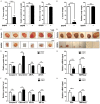A new compound targets the AF-1 of androgen receptor and decreases its activity and protein levels in prostate cancer cells
- PMID: 33415022
- PMCID: PMC7783748
A new compound targets the AF-1 of androgen receptor and decreases its activity and protein levels in prostate cancer cells
Abstract
Increased expression levels of constitutively active androgen receptor splice variants (AR-Vs) cause alterations in AR signaling, resulting in drug resistance and failed hormone therapy among patients with advanced prostate cancers. Several available compounds targeting the androgen axis and AR signaling have not demonstrated efficacy in preventing prostate cancer recurrence. Here, we investigated whether a new agent, 6-[6-ethoxy-5-ispropoxy-3,4-dihydroisoquinolin-2[1H)-yl]-N-[6-methylpyridin-2-yl]nicotinamide (EIQPN), has the potential for treating advanced prostate cancer. EIQPN interacted with the AR-activation fragment-1 (AF-1) domain and blocked its androgen-independent activity, robustly decreased the protein levels of AR and variants in prostate cancer cells by inducing AR protein degradation, and inhibited the androgen-independent proliferation of various AR-positive prostate cancer cells. In xenograft mouse models, EIQPN blocked the tumor growth of androgen-independent prostate cancer cells. Overall, these findings indicate that EIQPN could serve as a novel therapeutic agent for advanced recurrent prostate cancers.
Keywords: Prostate cancer; androgen receptor; androgen-independent activity; protein degradation; splice variant.
AJCR Copyright © 2020.
Conflict of interest statement
None.
Figures






Similar articles
-
6-(3,4-Dihydro-1H-isoquinoline-2-yl)-N-(6-methoxypyridine-2-yl) nicotinamide-26 (DIMN-26) decreases cell proliferation by induction of apoptosis and downregulation of androgen receptor signaling in human prostate cancer cells.Chem Biol Interact. 2016 Dec 25;260:196-207. doi: 10.1016/j.cbi.2016.10.008. Epub 2016 Oct 5. Chem Biol Interact. 2016. PMID: 27720946
-
Beyond androgen deprivation: ancillary integrative strategies for targeting the androgen receptor addiction of prostate cancer.Integr Cancer Ther. 2014 Sep;13(5):386-95. doi: 10.1177/1534735414534728. Epub 2014 May 26. Integr Cancer Ther. 2014. PMID: 24867960
-
Growth Inhibition by Testosterone in an Androgen Receptor Splice Variant-Driven Prostate Cancer Model.Prostate. 2016 Dec;76(16):1536-1545. doi: 10.1002/pros.23238. Epub 2016 Jul 30. Prostate. 2016. PMID: 27473672
-
Current strategies for targeting the activity of androgen receptor variants.Asian J Urol. 2019 Jan;6(1):42-49. doi: 10.1016/j.ajur.2018.07.003. Epub 2018 Sep 29. Asian J Urol. 2019. PMID: 30775247 Free PMC article. Review.
-
Regulation of androgen receptor variants in prostate cancer.Asian J Urol. 2020 Jul;7(3):251-257. doi: 10.1016/j.ajur.2020.01.001. Epub 2020 Jan 25. Asian J Urol. 2020. PMID: 33024700 Free PMC article. Review.
Cited by
-
Ion mobility mass spectrometry unveils conformational effects of drug lead EPI-001 on the intrinsically disordered N-terminal domain of the androgen receptor.Protein Sci. 2025 Jan;34(1):e5254. doi: 10.1002/pro.5254. Protein Sci. 2025. PMID: 39665260 Free PMC article.
-
JAG1 Intracellular Domain Enhances AR Expression and Signaling and Promotes Stem-like Properties in Prostate Cancer Cells.Cancers (Basel). 2022 Nov 21;14(22):5714. doi: 10.3390/cancers14225714. Cancers (Basel). 2022. PMID: 36428807 Free PMC article.
-
TR3 Enhances AR Variant Production and Transactivation, Promoting Androgen Independence of Prostate Cancer Cells.Cancers (Basel). 2022 Apr 10;14(8):1911. doi: 10.3390/cancers14081911. Cancers (Basel). 2022. PMID: 35454821 Free PMC article.
-
Androgen receptor inhibitors in treating prostate cancer.Asian J Androl. 2025 Mar 1;27(2):144-155. doi: 10.4103/aja202494. Epub 2024 Nov 19. Asian J Androl. 2025. PMID: 39558858 Free PMC article. Review.
-
N-terminal domain of androgen receptor is a major therapeutic barrier and potential pharmacological target for treating castration resistant prostate cancer: a comprehensive review.Front Pharmacol. 2024 Sep 18;15:1451957. doi: 10.3389/fphar.2024.1451957. eCollection 2024. Front Pharmacol. 2024. PMID: 39359255 Free PMC article. Review.
References
-
- Bray F, Ferlay J, Soerjomataram I, Siegel RL, Torre LA, Jemal A. Global cancer statistics 2018: GLOBOCAN estimates of incidence and mortality worldwide for 36 cancers in 185 countries. CA Cancer J Clin. 2018;68:394–424. - PubMed
-
- Siegel RL, Miller KD, Jemal A. Cancer statistics, 2020. CA Cancer J Clin. 2020;70:7–30. - PubMed
-
- Mohler JL. Castration-recurrent prostate cancer is not androgen-independent. Adv Exp Med Biol. 2008;617:223–234. - PubMed
LinkOut - more resources
Full Text Sources
Research Materials
